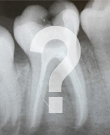A diagram demonstrating endodontic therapy (colloquially known as a root canal) on unhealthy or injured tooth: first drilling and cleaning, then filing with an endofile, and finally adding the rubber filling and crown.
Endodontics
What is Endodontic Therapy? What is a Root Canal?
Endodontic therapy is a sequence of treatment for the pulp of a tooth which results in the elimination of infection and protection of the decontaminated tooth from future microbial invasion. This set of procedures is commonly referred to as a "root canal." Root canals and their associated pulp chamber are the physical hollows within a tooth that are naturally inhabited by nerve tissue, blood vessels and other cellular entities. Endodontic therapy involves the removal of these structures, the subsequent shaping, cleaning, and decontamination of the hollows with tiny files and irrigating solutions, and the obturation (filling) of the decontaminated canals with an inert filling such as gutta percha and typically a eugenol-based cement. After endodontic surgery the tooth will be "dead," and if an infection is spread at apex, root end surgery is required. Although the procedure is relatively painless when done properly, the root canal remains a stereotypically fearsome dental operation.
Why is Endodontic Treatment Necessary?
The hollow space inside a tooth contains soft tissue called the dental pulp. Decay, repeated dental procedures, cracks or trauma to the mouth can cause the pulp to become irritated, inflamed or infected. When this occurs, endodontic treatment is needed. If left untreated, the result can be pain, prolonged sensitivity to heat or cold, discoloration of the tooth, swelling or a draining pimple on the gums.
Information from
![]()
Original image by Jeremy Kemp; SVG conversion by Jellocube27.



